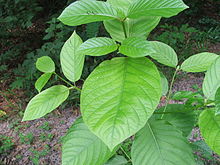
Back Biek ACE قرطوم Arabic قرتوم ARZ Mitragyna speciosa AST Кратом Bulgarian Sapat BJN Mitragyna speciosa CEB Mitragyna speciosa Czech Kratombaum German Κρατόμ Greek
| Mitragyna speciosa | |
|---|---|

| |
| Scientific classification | |
| Kingdom: | Plantae |
| Clade: | Tracheophytes |
| Clade: | Angiosperms |
| Clade: | Eudicots |
| Clade: | Asterids |
| Order: | Gentianales |
| Family: | Rubiaceae |
| Genus: | Mitragyna |
| Species: | M. speciosa
|
| Binomial name | |
| Mitragyna speciosa | |
| Synonyms[2] | |
| |
Mitragyna speciosa is a tropical evergreen tree of the Rubiaceae family (coffee family) native to Southeast Asia.[3] It is indigenous to Cambodia, Thailand, Indonesia, Malaysia, Myanmar, and Papua New Guinea,[4] where its leaves, known as "kratom" have been used in herbal medicine since at least the 19th century.[5] They have also historically been consumed via chewing, smoking, and as a tea.[6] Kratom has opioid-like properties and some stimulant-like effects.[7][8] As of 2018[update], the efficacy and safety of kratom are unclear.[9] In 2019, the United States Food and Drug Administration (FDA) stated that there is no evidence that kratom is safe or effective for treating any condition.[10] Some people take it for managing chronic pain, for treating opioid withdrawal symptoms, or for recreational purposes.[4][11] The onset of effects typically begins within five to ten minutes and lasts for two to five hours.[4]
Anecdotal reports describe increased alertness, physical energy, talkativeness, sociability, sedation, changes in mood, and pain relief following kratom use at various doses.[11] Common side-effects include appetite loss, erectile dysfunction, nausea and constipation.[12] More severe side-effects may include respiratory depression (decreased breathing), seizure, psychosis,[4][7][13][14] elevated heart rate and blood pressure, trouble sleeping, and, rarely, liver toxicity.[4][15][16][17] Addiction is a possible risk with regular use: when use is stopped, withdrawal symptoms may occur.[11][8] A number of deaths have been attributed to the use of kratom, both by itself and mixed with other substances.[7] Serious toxicity is relatively rare and generally appears at high doses or when kratom is used with other substances.[4][11]
As of 2018, kratom is a controlled substance in 16 countries.[7] There is growing international concern about a possible threat to public health from kratom use.[7][11][18] In some jurisdictions its sale and importation have been restricted, and several public health authorities have raised alerts.[11][18]
- ^ IUCN SSC Global Tree Specialist Group & Botanic Gardens Conservation International (BGCI). 2021 (2021). "Mitragyna speciosa". IUCN Red List of Threatened Species. 2021: e.T192376330A192376332. doi:10.2305/IUCN.UK.2021-1.RLTS.T192376330A192376332.en. Retrieved 6 March 2022.
{{cite journal}}: CS1 maint: numeric names: authors list (link) - ^ Mitragyna speciosa (Korth.) Havil. is an accepted name . Theplantlist.org. Retrieved 2013-12-26.
- ^ "Mitragyna speciosa". Germplasm Resources Information Network. Agricultural Research Service, United States Department of Agriculture. Retrieved 2013-12-26.
- ^ a b c d e f Rech MA, Donahey E, Cappiello Dziedzic JM, Oh L, Greenhalgh E (February 2015). "New drugs of abuse". Pharmacotherapy. 35 (2): 189–97. doi:10.1002/phar.1522. PMID 25471045. S2CID 206358469.
- ^ Hassan Z, Muzaimi M, Navaratnam V, Yusoff N, Suhaimi FW, Vadivelu R, Vicknasingam BK, Amato D, von Hörsten S, Ismail N, Jayabalan N, Hazim AI, Mansor SM, Müller CP (2013). "From Kratom to mitragynine and its derivatives: Physiological and behavioural effects related to use, abuse, and addiction". Neurosci Biobehav Rev. 37 (2): 138–151. doi:10.1016/j.neubiorev.2012.11.012. ISSN 0149-7634. PMID 23206666. S2CID 8463133.
- ^ Advokat CD, Comaty JE, Julien RM (2019). Julien's Primer of Drug Action: a comprehensive guide to the actions, uses, and side effects of psychoactive drugs (14th ed.). New York: Worth Publishers. p. 570. ISBN 978-1-319-20054-1.
- ^ a b c d e Gottlieb, Scott (6 February 2018). "Statement from FDA Commissioner Scott Gottlieb, M.D., on the agency's scientific evidence on the presence of opioid compounds in kratom, underscoring its potential for abuse". US Food and Drug Administration. Retrieved 6 February 2018.
- ^ a b Cinosi E, Martinotti G, Simonato P, Singh D, Demetrovics Z, Roman-Urrestarazu A, Bersani FS, Vicknasingam B, Piazzon G, Li JH, Yu WJ, Kapitány-Fövény M, Farkas J, Di Giannantonio M, Corazza O (2015). "Following "the Roots" of Kratom (Mitragyna speciosa): The Evolution of an Enhancer from a Traditional Use to Increase Work and Productivity in Southeast Asia to a Recreational Psychoactive Drug in Western Countries". BioMed Research International. 2015: 1–11. doi:10.1155/2015/968786. PMC 4657101. PMID 26640804.
- ^ White CM (2018). "Pharmacologic and clinical assessment of kratom". Am J Health Syst Pharm (Review). 75 (5): 261–267. doi:10.2146/ajhp161035. PMID 29255059.
- ^ Cite error: The named reference
fda4-3-19was invoked but never defined (see the help page). - ^ a b c d e f Warner ML, Kaufman NC, Grundmann O (2016). "The pharmacology and toxicology of kratom: from traditional herb to drug of abuse". Int. J. Legal Med. (Review). 130 (1): 127–38. doi:10.1007/s00414-015-1279-y. PMID 26511390. S2CID 2009878.
- ^ Cite error: The named reference
corkerywas invoked but never defined (see the help page). - ^ "Kratom (Mitragyna speciosa Korth)" (PDF). U.S. Drug Enforcement Administration. January 2013. Archived from the original (PDF) on 11 June 2016.
- ^ Marx, John, Walls, Ron, Hockberger, Robert (2014). "Chapter 156: Hallucinogens". Rosen's emergency medicine : concepts and clinical practice (Eighth ed.). London: Elsevier Health Sciences. pp. 2015–23. ISBN 978-1-4557-4987-4.
- ^ Cite error: The named reference
liverreviewwas invoked but never defined (see the help page). - ^ "Kratom". LiverTox, National Library of Medicine, US National Institutes of Health. 9 March 2017. PMID 31643176. Retrieved 29 March 2017.
- ^ Anwar M, Law R, Schier J (2016-01-01). "Notes from the Field: Kratom (Mitragyna speciosa) Exposures Reported to Poison Centers – United States, 2010–2015". MMWR. Morbidity and Mortality Weekly Report. 65 (29): 748–49. doi:10.15585/mmwr.mm6529a4. ISSN 0149-2195. PMID 27466822.
- ^ a b "Kratom profile (chemistry, effects, other names, origin, mode of use, other names, medical use, control status)". European Monitoring Centre for Drugs and Drug Addiction. 8 January 2015. Retrieved 12 September 2016.
